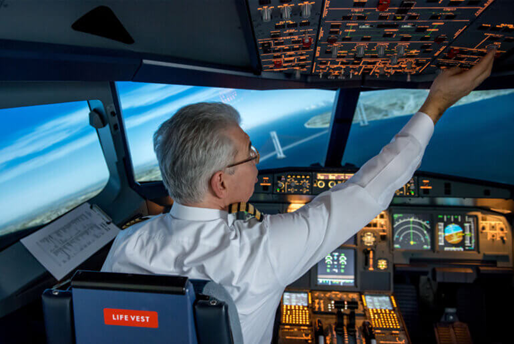近日,国际著名媒体PsyPost对重点实验室罗程教授等关于脑可塑性的研究进行了采访报道(神经工程与神经数据团队,负责人为尧德中教授)。在该研究中,罗程教授联合中国民用航空飞行学院的陈曦博士,以飞行操作作为一种特殊的脑可塑性训练方式,利用脑成像技术发现长期的飞行训练可引起了大脑注意、执行等相关脑区的功能增强。罗程教授等从2009年开始关注干预训练对大脑功能连接模式的影响,已经揭示了音乐、舞蹈、游戏等长期训练对特殊脑区的可塑性改变特征,并在专项训练的可塑性机制的基础上,发展了多种脑认知增强的方法技术。
飞行员培训需要长期接受严格的体能训练和飞行操作训练。飞行操作需要飞行员及时了解工作环境的所有相关信息,辨别信息的涵义和重要性,并做出正确响应。因此飞行操作是一项与高级认知密切相关的工作。罗程教授与陈曦博士合作,借助中国民用航空飞行学院的优势,在国家自然科学基金的支持下,开展了飞行训练的脑可塑性研究,已获得多项研究成果,引起了社会的广泛关注,本次又受到了PsyPost网的“认知科学”栏目的专访。
PsyPost是一家心理学和神经科学相关的新闻网站,致力于报道与人类行为,认知和社会学相关的研究。该网站涵盖了心理学、精神病学、神经科学、社会学相关领域的最新发现,传播关于心理学和神经科学研究的客观信息,对各种重要、有趣和被忽视的新研究进行更新。该网站从2010年创建以来,已经被国际各大知名媒体所参照(例如AskMen.com, ATTN, Big Think, Bustle, Cosmopolitan, Complex, Daily Dot, Elite Daily, Headline & Global News, International Business Times等),月阅读量超100万。
报道链接:
报道原文:

BY ERIC W. DOLAN NOVEMBER 14, 2020
Pilots display a different pattern of functional connectivity in the brain, according to new research conducted in China. The new studies examined interactions and synchronized activity between different areas of the brain, and the findings suggest that pilots tend to have enhanced cognitive flexibility compared to their non-flying counterparts.
“Civil aviation is a distinctive career. Pilots work in a complex, dynamic information environment. They must be aware of all the relevant information regarding this environment and recognize their meaning and importance,” said the authors of the new research in an article published in PLOS One.
Because of the cognitive demands placed on pilots, the researchers hypothesized that they would display a different pattern of brain connectivity compared to non-pilots.
The researchers used resting-state functional magnetic resonance imaging, a widely used tool for investigating spontaneous brain activity, to examine important neurocognitive networks in 26 pilots and 24 non-flying individuals who had a similar level of education.
Fourteen of the pilots were flight instructors from the Civil Aviation Flight University of China, while 12 pilots were first officers at airlines.
Compared to the control group, the pilots exhibited decreased functional connectivity within the central executive network and enhanced functional connections between the central executive network, salience network, and default mode network.
The decreased connectivity within the central executive network, which is associated with self-control and appraisal of threatening stimuli, “might enable the network to have more diverse functions,” the researchers said. On the other hand, the increased connectivity between the central executive network, salience network, and default mode network might be related to general cognitive performance.
In a similar study, published in Frontiers in Neuroscience, the researchers found that pilots also exhibited increased resting-state functional connectivity within the default mode network. The network has been referred to as the brain’s “autopilot” because of its link to mind-wandering and self-referential thought. It also appears to play an important role in switching between cognitive tasks.
“Pilots are always working in complex, dynamic environments. Flying is now not so much a ‘physical job,’ but a high-level cognitive activity. The pilot should be completely aware of all conditions in real time, and be ready to deal with various potential emergencies,” the researchers explains.
“These processes include continuous cognitive transitions, which are exactly the function of the DMN. Daily flying practice may activate the pilot’s DMN repeatedly and, ultimately, strengthen its activation level during the resting state.”
The study, “Increased functional dynamics in civil aviation pilots: Evidence from a neuroimaging study“, was authored by Xi Chen, Quanchuan Wang, Cheng Luo, Yong Yang, Hao Jiang, Xiangmei Guo, Xipeng Chen, Jiazhong Yang, and Kaijun Xu.
The study, “Altered Default Mode Network Dynamics in Civil Aviation Pilots“, was authored by Xi Chen, Kaijun Xu, Yong Yang, Quanchuan Wang, Hao Jiang, Xiangmei Guo, Xipeng Chen, Jiazhong Yang, and Cheng Luo.
(Image by Thomas Fengler from Pixabay)